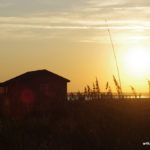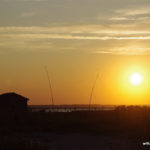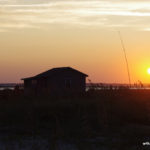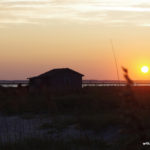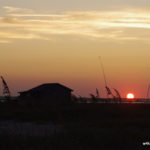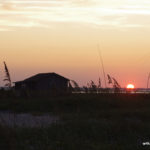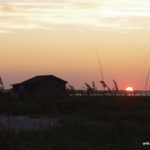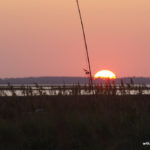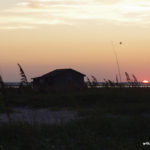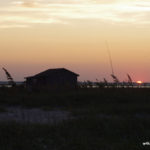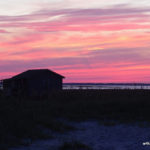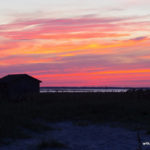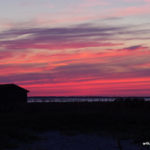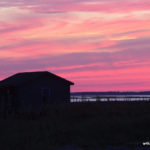Radio W4KAZ Thanks for stopping by the virtual KazShack. Feel free to comment - I often approve them.
|
By w4kaz, created on 2025.08.07 at 14:35:34 | last changed on 2025.08.10 at 12:50:25 | Photos from 2025 N4C IOTA and POTA activation: http://w4kaz.com/images/iota2025n4c/
The 2025 IOTA was run from one of the cabins at Cape Lookout(Iota NA067 and Pota US-0683) using the call sign N4C. Ops N4YDU and W4KAZ. N4YDU made the decision to tag along for the 2025 Iota contest outing. As always, having a world class operator means the radio will get a lot more actual use than it would have had I been alone. I am betting the log accuracy will be better too, at least for the YDU QSO’s. 😮
After returning from Field Day a month earlier I gave a bit of consideration to canceling the IOTA trip to Cape Lookout. Then decided to go ahead and keep the trip as scheduled. I’m not even sure if I nudged N4YDU or he asked if I was going, but after the first contact I made sure Nate knew there was plenty of room if he chose to make the trip. And plenty of operating time to fill if he chose to do it. “Highly motivated operator” is not a label I would ever apply to myself. My own interests are more about seeing what works and what does not.
WX es environmental konsiderationz
As luck would have it the weekend of the contest brought a few days of clear weather. The “weather tax” this time around was sticky-hot-humidity. Not only was the temperature elevated, but the wind was very mild for the NC outer banks. There were a couple of points where we even had dead air, drawing out the biting kritterz of the insecty sort. Gnats and green-head biting flies. At one humorous point, a literal cloud of gnats. Bitey-bitey!
Spraying the cabin window screens helped limit the gnat incursions into the cabin. Ants were present but thankfully not into the food and refreshments. Battery fans provided some moving air overnight to help permit sleeping in the ick. Even the rudimentary cabin was much more comfortable than setting up in and living in a tent in the style of a tropical DXpedition. Window screens, running water and a flush toilet beat the shit out of roughing it like the days before industrialization.
Antennaz? We are doing WHAT for Antennaz?!?
Maybe that’s how the conversation got started with ‘YDU, because I know I texted him to see if he had ever dorked around with a 40m OCF dipole. I had already decided to experiment using a 40m OCF fed directly with 300 ohm window line run back to the shack into a 4:1 balun, and a short coax jumper from balun to a tuner. The second antenna was to be a 59 foot doublet(K2AV suggestion from 2010) from FD and (failed)WPX. Once YDU jumped aboard ship he verified function of his butternut vertical and that was added to the list. For backups I had along a selection of other things(trap dipole, EFHE, linked dipole, etc) that we could have used in a pinch.
The OCF and the doublet were set up favoring Europe, parallel to one another and about 80 or 90 feet apart. The modeling on that seemed ok, but in hindsight I doubt I would do it that way again. The vertical was deployed in a mostly clear area to the NE of the doublet. The wire antennas were supported by 30 foot telescoping masts that are self supporting when mounted in the screw-in ground anchor bases. All of the exterior work got done Thursday afternoon after catching an empty slot on an earlier boat than the 2pm ride booked.
Since the OCF was fed directly with the 300 ohm window line and the balun located just a coax jumper away from the radio, I presume without actual measurements that the feedline was radiating in random directions along with the antenna itself. Probably not ideal, but the QSO’s got logged anyway. In practice there was little difference between the doublet and the OCF, while the vertical showed occasional improvements on some signals. FWIW the doublet had marginal less static/white noise/QRN than the OCF.
Radio? Where the hell is the stupid adapter? Why is this an RCA jack?? WTF????
Setting up the station was an exercise in “where is that cable”, since the last couple of times had been with the K2 instead of the K3. Everything needed was there…somewhere. The Elecraft K3 was used. Logging under Writelog, which took YDU a while to adjust to his preferences. The wire antennas were both routed from their baluns to an MFJ tuner that was used as an A/B switch in the tuner bypass positions. The tuner’s antennas routed to the K3 antenna one position and the vertical was routed to the K3 antenna 2 position. The K3 internal atu was used for matching to the wire antennas, and not generally needed for the vertical. After pulling a bad set of headphones everything was working. Too easy. It is NEVER that easy.
Contest? There’s a Contest today?
N4YDU started out hot from the gates and chased mults and called CQ. 15m was the big surprise for me, as the 15m band has seldom been open during this contest for this QTH over the past several years. The low USA activity levels make the first 8 hours of the contest somewhat of a challenge. The EU stations tend to concentrate on working other EU. Since the Cape Lookout QTH is also a POTA entity, for my part I alternated calling CQ for IOTA and POTA. The self spotting rule change allowed us to post spots in the POTA system. This resulted in some decent rate hours that have been really dead in the past. I hit 15m and 20m hardest for POTA, and neglected 40m entirely. Probably left a lot of POTA Q’s on the table by never getting to 40m.
As the afternoon grew longer it sounded like 20m was ready to open pretty well to Europe, so I wanted YDU to have a shot at the possible higher rates. Also better to have the better op on the radio when 40m opens. While it was nothing like a major contest rate wise, the best rates we had were centered on local sunset on 40m. YDU pulled the plug for the evening around 0400Z. The early morning/local sunrise hours did not produce any JA, KH6, ZL or VK, much to our disappointment. 80m over-performed beating out 10m by 16 QSO’s and 4 mults.
The Good, The Bad, and The Ugly
The Good: As always, enjoyed have N4YDU along for the trip. We had a bit more time for setting up as we were able to catch and earlier boat to the island than the one scheduled. That alone gave us an extra two hours to set up antennas and such. All of the antenna systems functioned as expected and no repairs/redo’s/debugging was required on the antenna systems. The radio systems were “mostly” ready to plug and play, but I will need to repack/review/reequip the radio set ups with the goal of having each radio packed individually as a stand alone unit. WX goodness was complete lack of thunderstorms, a rarity over the past 10 years.
The Bad. The worst part was weather related. Although we were spared any electrical storms, that was all due to a high pressure system sitting over the region that also drove the temps into the mid 90’s (95F/35C) with the associated oceanside high humidity. Just like being in Louisiana again! Except I’m no longer acclimated to the norms of S. Louisiana weather. Nathan took to dunking his shirt in ice water to get some relief. Normally Cape Lookout has a consistent breeze blowing that helps mitigate the heat, but we caught a couple of spells of nearly still air.
The UGLY: Bugfest 2025. The other downside to the still air is that it gives the biting flies and gnats(“Gnatzi’s”) freedom to roam. Just like being in Louisiana! Humorous anecdote reserved for in person grinz.
Addendum(2025-08-09): What Next?
The question naturally arises: “Is this 2025 Iota antenna plan how I would do it again?”. The answer that intermediately comes to mind is “NO”. But that would be the case just out of the curiosity of trying something new. If I were to deploy the same antennas again, I would have put the two wires at right angles based on how similar they functioned this year. Also, after some more research and modeling, I think the OCF needs to be rebuilt. It seems like feeding at 40% point makes more sense, giving a better match on 15m and 10m while keeping 20m and 40m at a low swr. (TO BE TESTED, 40m OCF with 27.5′ and 41.25′ legs[8.38m and 12.57m]). LINK: “Off Center Fed Antennas” W3TB youtube presentation, April 2023 WCARES. Also thinking about how and 80m OCF would fit into the favorite Iota QTH. Then there are the permutations and combinations yet tried(OCF and EFHW, doublet and EFHW). The grass is always greener, aina?
Contest Results:
N4YDU’s 3830 2025 IOTA Contest write up: https://www.3830scores.com/showrumor.php?arg=RvYizV77LDDxJU
 3830 scores for Multi stations and band breakdowns POTA Results
POTA hunters came in for the Q’s, and there were 42 P2P Q’s confirmed so far in the POTA system. Just guessing, but it looks like about 150 to 200 Pota hunters checked in, and that is probably a conservative estimate. Thanks fer the Q’s hunters!
Pota from Calo this year:
 Screenshot 2025-08-07 – POTA activations from US-0683, Cape Lookout National Seashore
By w4kaz, created on 2025.03.14 at 17:14:43 | last changed on 2025.03.14 at 18:15:48 | This year for the NC QSO Party I activated three Pota entities in three different counties. US-6909, Harris State Game Land(WAKe county), US-6920, Lee State Game Land(LEE county), and US-6916, Jordan State Game Land(CHAtham county).
After Action Photos
Did not take any photos during the event, but the morning after. The extension on the hitch mast support allows dropping the tailgate with the antenna deployed. On my last vehicles(a 4runner and Jeep Cherokee) I also had a front mount hitch, which I prefer to use for the mast. So far the only front hitch I have found for the Sierra hangs down too far. The ground clearance on the Sierra 1500 is too already low for my preference, only about 9 inches. Begs for a 3 inch lift. The “radio mount” in the vehicle is comical, a 5mm plywood board resting on a jack stand in the front and taped to the console in the rear, with the radio “secured” with more painters tape to the board. Hmmmm……sketchy, but functional.
 The truck hitch receiver with a step extension that supports the telescoping fiberglass mast. The mast du’jour is the Jac-kite 31 footer. Plus assorted extra junk in the truck bed.  The high tech radio install for the 2025 NC QSO Party. The battery is behind the radio sitting on the “parts-n-spares” tote. MFJ tuner in passenger seat on radio storage box. STATION
The station du-jour was the FT-891, logging with a kludged writelog half assed set up. For whatever reason Writelog was not flagging dupes, so I was trying to look them up manually while S&P. Mostly just went S&P while trying to find a clear frequency.
Used a telescoping fiberglass mast at all three sites, which showed more droop than expected. The telescoping mast was supported in a hitch mounted pole support with the base of the mast resting on the ground. The antenna was a 58 foot doublet fed with 300 ohm ladder line into a 4:1 balun, with a short coax jumper into an mfj-949 tuner, radio set at 100w. Logging on a laptop running Writelog, which could send frequency changes to the radio but was not polling and keeping the log updated when spinning the dial on the radio. At the third and final stop the antenna was modified to extend the length to 90 feet for better use on 80m. Power to the radio is supplied via a 100ah LifePO4 stand alone battery. Radio conditions seemed excellent for most of the day. The broadcast stations on 40m became troublesome, should have moved to 80m late. Lack of sleep kicked in late though, and I bailed with an hour of time left on the table.
The Day
The day started out at US-6909 on frozen ground. Arrived a bit early to set up before NCQP startup, but was running late anyway. Wound up doing only SSB. Could not get any results on 20m, so moved down to 40m to work more locals. Ran into that days’ only problem when the keypad caused problems with the radio. More on that later….. In the meantime, had a decent time at that location.
Moved on a few minutes earlier. The second location at us-6920 was in full sun, but had the best rates of the day. As the afternoon wore on I began to miss the freezing weather from a few days earlier. Operating in the vehicle was a bit warm under the clear skies with temps almost hitting 60 outside. But the 20m pileup of Pota ops was worth the sweat.
The final location, US-6916 was a good choice logistically, but the band was crowded and it felt like folks were not taking into account the park and county had changed. Note to self: Game lands get REALLY dark, bad idea to misplace the flashlight.
Musings In-No_Particular-Order
Generally, it was a pretty fun outing. I’m torn between using Writelog, which I really like, but does NOT FUNCTION PROPERLY with my FT-891, or finally switch to N1MM which I generally HATE WITH A PASSION. Suckage either way, although the FT-891 itself is more than likely the point of failure. I can probably get over my N1MM hate fetish, but the ft-891 would still be a problem due to the dread “Cat Control Tick”. FT-891 Tick worse than N1MM which is worse than Writelog not working with the 891. ??PAPER LOGS???
So in this case I used Writelog anyway, and resigned myself to fucking up the log. I like Writelog, and I like the ft-891 as a radio. Maybe N3FJP is the solution, I already have the license, I like it better than N1MM, and I had it working with all of the radios(ts-590/K2/K3/ft-891).
Other minor issue…..somewhere Saturday loading the truck I misplaced the FH-2 keypad. WTF!?!?!? I had the home brewed keypad, so I used that, but it was causing it own issues. Like for some reason when trying to record messages it was changing the radio frequency instead. NOT GOOD. The temp solution was to use the radio controls to record the messages, and forget about customizing the radio message memories on the fly. I hope the FH-2 keypad turns up when I ransack the vehicle tomorrow.
Other issue….I gotta learn how to pare the gear down. A correctable personal deficiency. Not EASILY correctable, but correctable. 🙁
Observation-1 ….The 58 foot doublet K2AV came up with several years ago for use in the IOTA contest is a really good general purpose antenna for 40/20/15/10. It was originally designed to allow the Elecraft K3 internal tuner to find a match, so it is a piece of cake for an external tuner. At the last stop I added legs to increase it to a 90 foot doublet to allow using it on 80m/75m, and easier match for the tuner. The shorter length models well showing useful patterns on all four bands and matches easily. Use the K3 in the car? A possibility.
Observation-2 ….The antenna used was constructed of 16ga wire, The mast droop is substantial especially with the longer legs. Time to try 18ga wire again? The 26ga stealth wire?
Results:
NORTH CAROLINA QSO PARTY
Call Used : W4KAZ
Last County Ran : CHA
Callsign(s) of Operators(s) : W4KAZ
Entry Class : Single Op – In State
BAND CW PH MULTS
==========================
80 0 0 0
40 0 167 59
20 5 123 27
15 0 0 0
10 0 0 0
Note: The one DX mult (if worked) not shown in band breakdown
Multipliers : 86 NC Counties/State/Prov
Extra DX Mult : 1
W4NC Bonus : 0 pts
W4WS Bonus : 0 pts
W4NC+W4WS Bonus : 0 pts
Cherokee Bonus : 50 pts
Dare Bonus : 0 pts
Both CTY Bonus : 0 pts
Contact Points : 595
Total Mults : 87
Claimed Score : 51815
I have followed the North Carolina QSO Party Rules
ALL Operators must sign clearly, including callsign
Signature(s): ___________________________________
Date: ______________
MULTIPLIERS WORKED:
ALA ALE ASH AVE BLA BRU BUN BUR CAL CAM CAR
CHE CLA CLE CUM DVD DUR FOR FRA GUI HAR HEN
HYD IRE LEE LEN LIN MAD MCD MEC MIT MON MOO
NEW ONS ORA PEN PEQ PIT RAN ROC ROW RUT STA
STO SUR TRA UNI WAK WAT WIL YAD CT MA NH
RI VT NY NJ DE MDC PA AL FL GA KY
SC TN VA AR LA MS OK TX MI OH WV
IL IN WI KS MN MO SD NB ON
You have also been credited with one mult for DX
By w4kaz, created on 2022.06.22 at 20:52:46 | last changed on 2025.01.06 at 10:05:18 | Trap dipoles Part one. .. Trap dipoles Part Two
[edited for links and notes, 2023/07/15] The original trap dipoles were constructed using coils and caps. Using Rg-58 for the coax style trap dipoles was rejected because of the weight and size of rg-58 coax traps. Using RG-58 defeated the primary goal of making the antenna as light weight as possible.
Somewhere I picked up the notion of using rg-174 or rg-316 type mini coax to make the traps. It looks like the voltage ratings on the rg-174 is higher(1100v rms), so that was chosen for the first experiments. If luck holds out, the tiny coax will be sufficient for use on the dipole traps for a full 100w CW. Using the smaller lighter mini coax will allow for lightweight construction from easily available materials that can be easily supported using telescoping fiberglass masts like those available from Spiderbeam, MFJ, or Jackite. i.e., perfect for portable, field day, rover QSO parties, or POTA/SOTA.
The trap calculator program hosted by KC1KCC gave me some starting numbers to work with, and actual trap measurements came out quite close to the calculated values. [alternate calculator at K7MEM]  The traps are built with the coax coils wound reasonably tight to the form, and the coils were taped down with electrical tape prior to taking measurements. These are all wound on small sections of the same sort of plumbing drain tailpieces that are 1.5″ od (38mm od). (e.g., in the US available from Lowes or any hardware store selling plumbing supplies.) The table below are of traps as built and tested with the nanovna.
| frequency |
turns rg-174 |
|
| 27.7 |
3.33 |
|
| 20.66 |
4.33 |
|
| 13.75 |
6.1 |
|
| 6.75 |
10.3 [calculated] |
|
Update, 2024-04-04
Received a new 1 inch o.d.(~25mm) form material that is lighter. testing.
Freq———–# turns calculated——#turns actual——-
27.7Mhz—>5 turns (approx)—–> 5 turns, 24.8Mhz(use 4.5?)
20.66Mhz–> 6.25 turns————> 6.25 turns, 19.65Mhz(use 6)
13.75Mhz—> 8.75 turns ——–> 9 turns, 13.5Mhz & 13.7Mhz
6.75Mhz—-> 16.33 turns
END 2024-04-04 Update
Test Antennas:
The test antennas were built for the CW segments of each band. With the best SWR centered on the xx.070 area it will probably give enough coverage for both CW and SSB operation without a tuner. An 80m/40m version will require tails for 80m adjustments.
Testing of two antennas was done before the May 2022 CQ WPX CW contest. The 20m/15m version tuned easily….after I figured out I was working on that instead of the 10m antenna. Read those labels, because at least I had them labeled properly when they were built several weeks earlier. The 10m/15m version also tuned easily.
[aside: the 15m/20m trap is now in service as the skimmer station antenna, after a recent storm broke the 160m inv-l]
Although I missed the WPX contest, I soon got a chance to do antenna testing at 100w levels.  Both antennas handled the power easily with no signs of SWR rise. Both were tested at 10 seconds, 30 seconds, 60 seconds and five minutes of CW key-down.
Hoping for good conditions in FD to allow testing of the 10m/15m version. Sunspots, do your thing!
[2023-07-15 additional notes] The coax traps began showing swr problems on 10m after a few months in the weather. Expecting this to be a problem with water intrusion. testing the use of WeldBond glue as a sealant. [alternative….Elmers ProBond] Also testing the adhesive as a sort of q-dope to seal the coils on the form.
By w4kaz, created on 2019.09.28 at 12:41:11 | last changed on 2019.09.28 at 12:41:13 |
2019 brought another solo operation for IOTA, but return to Cape Lookout for the event. Weather was much better than 2018, the only WX challenge being the winds. Normal for the islands on the NC coast, and very agreeable for comfort, but it caused the only bit of trouble for the antennas.
Antennas were set up on Friday. This year two folded dipoles were used, one for 40m and the second on 20m. A hy-gain AV-18VS vertical was set up in the unlikely event 15m or 10 would open. (Neither did for me)
Checking the tuning on the antennas had me chasing shadows for too much of Friday afternoon. After sorting out the feedlines, there was still an SWR problem on the 40m folded dipole. These had been tested at home before the contest, but had been tugged on quite a bit trying to straighten the mast in the high winds. So as a fallback measure I hoisted the 40m/20m trap dipole, and tabled the folded dipole problem. In the end it turned out to be a problem with the antenna analyzer rather than the antennas. Since it was already in the air, I just re-positioned the trap dipole to be at right angles to the folded dipoles. But that was after all too much walking from shack to antenna several times looking for problems.
-
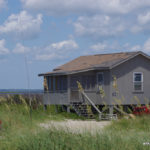
-
W4KAZ IOTA 2019
-
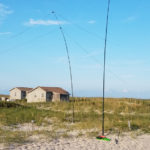
-
W4KAZ IOTA 2019 Antennas
-
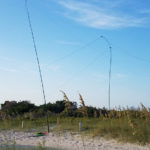
-
W4KAZ IOTA 2019 Antennas
-
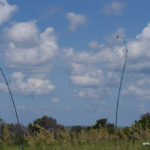
-
W4KAZ IOTA 2019 Antennas
-
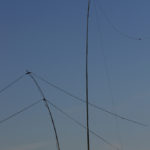
-
W4KAZ IOTA 2019 Antennas
-
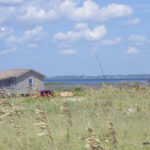
-
W4KAZ IOTA 2019
-
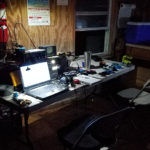
-
W4KAZ IOTA 2019 station
-
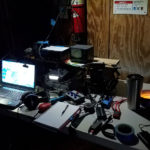
-
W4KAZ IOTA 2019 station
-
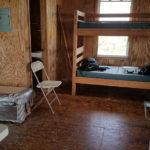
-
W4KAZ IOTA 2019
The remainder of Friday evening was spent relaxing. It was more of a vacation than an operation, so time for beverages and a nice cigar was available. A nice spot for stargazing was found on the front steps to the cabin, and several nice meteor streaks crossed the Milky Way.
One of the best moments was a visit by Chris, WX4FLY. Really enjoyed meeting Chris, learned a lot of info in our chat. I also got an eyeball QSL card that may be one of the best custom cards I have run across. Thanks Chris.
-
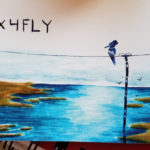
-
WX4FLY eyeball QSL
Radio conditions at the start of the contest were poor. Radio conditions in the afternoon were poor. Radio conditions in the early evening were poor. Radio conditions overnite were poor. Interest in operating the contest was low, so it was all done in a series of segments lasting 30 to 60 minutes. After a decent hour or so on 40m after it opened, I received a final distraction in the form of a phone call from a long lost acquaintance. Also a cold beverage and a nice cigar.
| Call |
SO2R |
Remote |
CW Qs |
CW Mults |
Ph Qs |
Ph Mults |
Op Time |
Score |
Club |
| W4KAZ |
* |
* |
84 |
20 |
16 |
5 |
10 |
18,750 |
PVRC |
I included an extra day on the end this year to allow packing up to be more relaxing, allow more relaxing, beach side relaxing, and to allow a bit of relaxed operating in an activation for Parks On The Air. The parks hunters were a lot more plentiful than IOTA contest QSO’s, so I handed out 60 or 70 Qsos for Cape Lookout Seashore, a successful activation. For that I used the vertical antenna on SSB, just to give it a shakedown of sorts. All of the antennas and outdoors kit was packed before sundown, and another enjoyable evening of looking for a good fireball followed.
The island was hit pretty hard by hurricane Florence in 2018, and again by Dorian in September 2019. It had changed since 2018 IOTA, and I imagine it will have changed again. Hopefully damage was not as severe as the cabin area to the north, which had a new cut that ran directly through the cabin area, plus lots of other cuts and beach erosion.
The stiff breeze helped keep the islands indigenous obnoxious life forms under control until almost time to leave. Win. Win. Win.
More interesting than the IOTA contest……The lack of decent 20m conditions had me out experimenting with the camera instead.Â
And that, a sprinkling of meteors across the Milky Way, combined with the mild weather to make the trip a winner..
Â
By w4kaz, created on 2018.07.22 at 11:58:16 | last changed on 2018.08.27 at 17:39:43 | The normal group of Field Day scalawags were in the wind for 2018. N4GU was uncertain if the QTH from 2016 and 2017 would be available. N4YDU took up N9NB’s offer for FD at Ted’s QTH in VA foothills. I was also kindly invited, but decided that I didn’t want to drive quite that far, despite the nearly ideal location. I do love me some VA mountains.
Photos from FD2018: http://w4kaz.com/images/fd2018/
For 2018 I took exit ramp #3, and went with the backup backup plan. Operated 1B at a campground near Wilmington NC. A nice easy drive, with a couple of easy on/off stops along the way to stretch out the body parts complaining loudest. That made the drive tolerable.  Also made it into a mini-escape, leaving home QTH on Thursday with a return on Monday morning.
Weather conditions[i.e., heat] soon had me thinking I’d have been better off in the VA mountains, but after acclimatizing to “swamp butt” conditions, it was fine. When I sweat enough to remind me of living on the South coast – its pretty darn sticky. Usually not quite so bad in NC, but it happens enough to know to be prepared. Lots of water and gatorade. Thursday afternoon was the worst of it though.
Friday morning was spent doing a bit of unrelated recon. Friday afternoon I laid out the antennas and supports, and some more unrelated area wide explorations. WX on Saturday dryed out some, and there was a nice breeze that picked up from the start of operations though early evening. Never a drop of rain, just temps and humidity in the 90’s. Just like being back in good ole Bigg Swampy(SE Louisiana).
Antennas:
2018 was a time to test some antenna ideas. I built a 2 band triangular yagi for 20m/15m, based on article by Herb,N4HA as published in June 2018 QST. I kept to the published dimensions(mostly) but fashioned the driven element(s) from 300ohm ladder line. For supports I used a mast from Henry, K4TMC as the support for the drive element/apex. The tails sloped down to connect to the reflectors, and those ends were supported by 2 masts cobbled together by combining a Shakespeare Wonderpole on top of a section of 4 foot mil surplus mast.  Simple, and easier than I expected. This antenna was fed with 300 ohm ladder line run to a tuner rather than coax.
40m was a simple inverted Vee supported by a Spiderbeam 12m telescoping mast. Note: Simple does not mean “easy”.
10m was an afterthought. After struggling with the 40m dipole-that-wouldn’t, I had a relaxing breakfast and gave some thought to 10m. Had plenty of time, so may as well. To get on 10m I made a dipole by cutting a couple of equal 8.5 foot lengths of wire and constructed a “FD style” center insulator from a pair of cable ties taped together. Used a “composite” feedline – a ladderline drop to a 1:1 unun and a short coax run into the tent. I had a length of ladder line about 25 feet long so the 10m dipole was up about 23 feet.  At the end of the ladder line at ground level I plugged the ladder line into a 1:1 unun, and ran the last 30 feet or so into the station with coax. From start to finish this antenna took about 30 minutes to put up, including cutting legs and twisting it all together.
No antenna at all on 80m. Decided I’d have enough business on 20m & 40m to keep occupied, and figured on sleep rather than a night of 80m T-storm QRN. 😮
Now, about that 40m Vee. The antenna that would NOT. Still not certain where the problem was, but it had an issue in one of the feedlines somewhere[update-think one of the legs has broken wire]. Far too much time was wasted raising and lowering the antenna trying to debug the issue. Lesson1: Always have an alternative.  Lesson2: Don’t dick around debugging when you have the alternative at hand ready to go. Lesson3: Save debugging for down time. Lesson4: Read Lesson1 and Lesson2 until they really sink in.
Operating:
Once the CQ’s started, there were plenty of QSO’s to log. Saturday was a bit slow at first, but I got a better rhythm in the evening. Was tired though, and sacked early, including a 45 minute nap at 5pm in the nice cool breeze that came up. Also got up early Sunday, 5am-ish.  Sunday morning was quite a bit of fun, right up until my keyer interface died around 11am. So I finished the event with a bit of lackadaisical SSB, mostly S&P.
Camp:
The Cabelas tent goes up easily. My only regret is not getting one of the larger sizes. It has room for setting up a table for the station and also for a cot along the opposite side. But it is a bit cramped. Next time I do this I think I will use a screen tent for the station and the tent just for snoozing/bad wx. Also, the ideal site would allow for the tent to use an overhead spike support and avoid the need for the center pole.
Overall a big win. Keeping the ants away…..the real challenge!
By w4kaz, created on 2017.07.15 at 13:42:17 | last changed on 2018.07.15 at 13:43:00 | The 2017 Field Day is in the bag. Â Operated with the group as AA4NC at the farm of N4GU’s XYL. Â Showing a surprising lack of judgement for a second year in a row, AA4NC again allowed us to use his call, despite a shoebox full of notices from last year’s operation. Â Still No Will….but N4GU, N3ND, N4YDU, N9NB, W4BBT and W4KAZ all on the air.
2016’s as-yet-undocumented FD last year was done as class 2A, while for 2017 we rode with class 3A. Â Given the improved conditions on 15m/10m/6m, that was quite a bit less boring than I expected. Â Gave N4YDU grief for wanting to run that third station for the high bands, but they were maybe the money bands this year. Â Great call on N4YDU’s part. Â With so much activity on high bands through the evening and mid-watch, 80m under-performed. Â Boooo. Â Hoooo.
Stations:
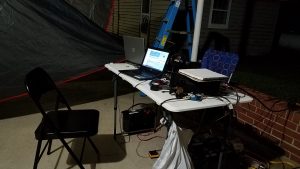 2017 FD – 15m/10m and 6m stations |
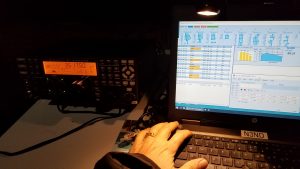 2017 FD – The REAL Night Shift |
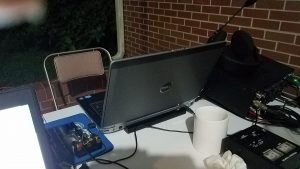 2017 FD – The “40m station” |
We ran 2 stations on N4GU’s 1kw generator, and ran the third station and VHF stations on deep cycle batteries. Â The two stations on generator power were Elecraft K3’s, and the battery station was a Kenwood TS-590. Â VHF was run on the Kenwood until N9NB arrived with an Icom 703. Â Battery power for the 590 was two deep cycle batteries paralleled and connected to a solar cell, and the 703 was on a single deep cycle battery.
Antennas were a Frankenstein ??ta33M?? tribander for 10/15/20@35′(split via triplexer), an OCF mostly for 40m@34′, an 80m dipole@~45′, a 10/15 fan dipole @ 30′, Â a 20m vee dipole at 24′ and a hastily erected 40m dipole @ 40′. Â VHF station used a 5 element 6m yagi @24′. Â Most of the antennas were strung by late Friday afternoon, leaving time on Saturday morning for testing and a last minute wild hair(the 40m dipole.)
Operating:
Given the strange conditions on Sunday morning, the dipoles played quite well as supplements to the tribander on 15m and 20m, with good signals from New England often better on the dipoles. Â The tribander won on stations out to the west of 9-land, and about equal in the middle grounds between.
For my part 15m was the best news on the subject of propagation. Â 20m and 10m were close behind. Â All three bands were very productive. Â 6m even coughed up QSo’s this year, with 160+ Q’s logged. Â The night shift on 80m was a bit sluggish, probably many stations stayed on 20m later than normal.
Something must have worked correctly, event with W4KAZ constantly changing the function key settings on every N1MM computer attached to an HF radio.  Despite KAZ’s  best efforts at disabling the dread “Enter Sends Mode”, almost 3500 Q’s were logged across all of the stations.
WX:
Friday afternoon the WX forecast of rain was quite thankfully incorrect. Â Instead there were crystal clear blue skies and a slightly gusty wind. Â The wind helped keep the insects at bay, and cooled the crew off a bit. Â Saturday morning was overcast, but remained dry right up until a 6pm shift change. Â As soon as the new shift sat at the stations, the wind began gusting, enough to slide the camp chairs across the cement floor as if of their own volition. Â Enough wind to make ops press down on tables to keep them from tossing radios about like so much flotsam. Â The rain soon came in buckets, making the nice covered carport seem like luxury FD accommodations. Â The nice 30 minute storm cooled things down and brought the insects from hiding for most of the evening. Â Things remained cool enough overnight that a light rain jacket was perfect for both staying warm and fending off the creepy-crawlies.
Food and other:
Many thanks to Mike’s XYL Sherry, who kept us stuffed to the gills over the weekend, and caused disputes to break out over a certain blueberry dump cake. Â Also many thanks for allowing us to invade her domain for the weekend and play radio geek. Â Good QTH, a good crew of ops to work with, and entirely too much fun.
By w4kaz, created on 2016.10.27 at 09:21:59 | last changed on 2016.11.02 at 19:51:57 | 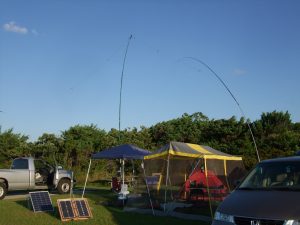 Most of the 2015 W4O IOTA station from Okracoke Island. 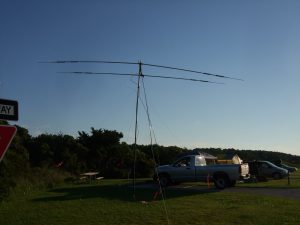 Tri band yagi at 18 feet. After a lot of foot dragging and interruptions, all of the components required for a 100w battery operation had been acquired at casa W4KAZ in late spring 2015. Â The first test run was a 1E Field day operation at home. Â But better to put it to use afield.
So N4YDU was game for the field test on Okracoke island for 2015 IOTA. Â N4YDU and I operated as W4O from Okracoke Island on the NC outer banks, just south of Hatteras. Â Access to Okracoke is by boat, so we booked slots on the ferry out of Swan Quarter for Thursday afternoon. Â This worked well, allowing for set up and test operating well before the Saturday start. Â Also a nice break for a meal for lunch Friday down in Okracoke village. Â QTH of the operation was the NPS campground on Okracoke.
WX Conditions on Thursday were cool with an all day drizzle. Â Ugly, but no thunder and lightening, so not terrible. Â Set up of camp was delayed until early evening. Â Thursday night was warm, damp and still. Â Friday morning brought clear skies and an nice cooling breeze out of the north. Â The WX was much improved for the rest of the weekend. Â Thursdays rain was the harbinger of a very welcome unseasonable cool front, and WX for the bulk of the weekend were very comfortable with much lower than normal temperature and humidity – perfect for field operations.
Radio propagation did not live up to the WX, so there were periods of slow conditions. A nice breakfast is always good.
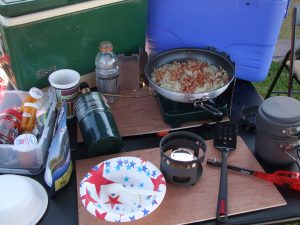 Breakfast. Solar Power
The solar set up included two 30w solar cells sending power to the charge controller and two deep cycle batteries. Â Our solar cells were augmented by the temporary loan of an 85w solar panel by WB8YJF, Jon. Â WB8YJF vacations at Okracoke every year at this time, and with his help we had a strong 8A charge current throughout the day Saturday.
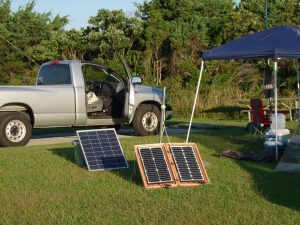 Solar cells out catching a tan on the island. My own small cells in the foreground and WB8YJF’s loaners in the rear. 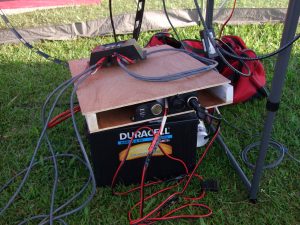 Batteries and charge station Having the battery fully charged going into the evening hours was nice. Â Rates slowed fairly early, so two days of beachside life had us leaving a few possible qso’s on the table. Â Sleep was the better option.
Station
The station consisted of the batteries, feeding power to the Elecraft K2. Â Antenna supports consisted of several fiberglass masts. Â All of the masts have been modified by drilling holes at the base of each mast section for pins. Â Hitch pins are used for the smallest sections, and 2 inch cotter pins are used in the larger sections. Â This was faster and more secure than using hose clamps, but it may ultimately weaken the masts over the long term. Â That trade-off seems worthwhile for the time saved on deployment and take down.
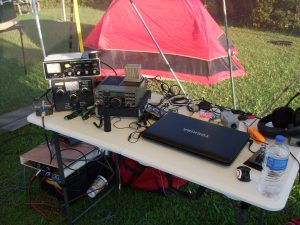 The W4O station, an Elecraft K2, a couple of tuners and logging laptop The 33 foot fiberglass pole from TheMastCo was used as the center support for a lightweight fan dipole for constructed from 300 ohm twin lead and surplus field wire, covering 40m/20m. Â A 22foot fiberglass flag pole combined with most of a 20 ft. Shakespeare wonder pole was used to support an inverted-L for 80m. Â Thirteen foot crappie poles were used to get the ends of the dipoles and vertical as high as possible in the limited space offered by two spaces in the campground. Â We also deployed a 2 element triband yagi on five sections of surplus military camo mast, at a height of about 18 feet.
Radio conditions were poor, but the WX was unusually good for the NC coast at the end of July. Great trip and another successful field test of something different.
By w4kaz, created on 2015.07.11 at 12:27:11 | last changed on 2015.07.11 at 12:43:05 | Life’s swirl of events led me to be non-committal about FD with the usual suspects this year.  Probably a good thing, given the way brown stuff keeps making sudden contact with the rotary impeller.  Even the minimal home operation in lieu of a real event was in question as days grew shorter.
So 2015 FD was flying solo in the KazShack.   [Some photos here]  The twist to make it FD was to run the station on emergency power, class 1E.  With enough ’round-too-its’ having been previously cashed in to assemble a portion of the battery set up  desired, the battery op seemed feasible. Accumulated over the past year are a couple of 30w solar panels, a pair of well-matched deep cycle marine batteries, a decent charge controller, and assorted minor peripherals(cables, connections, etc).  The original plan was to be ready for NC-QSOP earlier in the year.  Brown Stuff vs Rotary Impeller.  Brown Stuff won, no Qso party.
In field day spirit, I also hoisted an “emergency” field portable 40m/20m inv-V off of a fiberglass telescoping mast obtained from “The Mast Company” several years back.  After collecting dust for these years, it occurred to me that it could fill a big unused space on the edge of the ‘wire-farm’, backed up very nicely by the 20m/40m reflectors in their permanent positions.  This worked very well on both bands during FD, showing four or five S-units difference depending on conditions and the direction of the signals.
The 2015 FD Station:
For the event, I relocated the solar panels to be within reach of the feeder cables to the shack. The batteries had been connected to the solar panels for over a month, so they were nicely topped off.  The batteries were brought into the shack, and connections were set up to power the K2 as the load off the controller.  Not willing to go whole-hog QRP, all transmitting was done at intermediate-low power levels, 45w overnight, 75w during daylight.  (Based on actual current draws by the K2 as measured in place). Add a laptop and ready to go.  The antennas were the normal wire farm plus the hasty-install dipole on the fiberglass mast.
The Solar Problem:
Expected to have poor results from the solar panels, as their default location for the shack is only in full sun in the afternoon. Â Hoped for a sunny afternoon on Saturday. Â No. Such. Luck. Â In fact, the WX really sucked. Â When the WX didn’t suck, there was lightning and rain. Â Zero sunlight. Â The panels only produced about .3amps in shade under clouds, instead of their full-sun 2.8amps. Â 90% reduction.
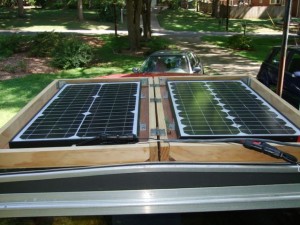 Solar panels, laid out on the conveniently parked truck 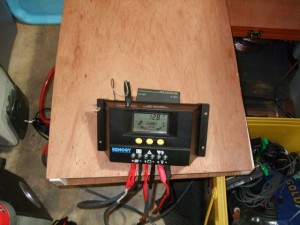 Charge controller for solar power
The good news is the batteries seemed up to the challenge on their own.  Battery voltage dropped to 12.3v at its lowest.  The K2 drew only about 11 amps in transmit, and just over 1/3 amp when in receive. If the panels had been in a good full-sun location the charging would probably have kept up with the demands during daylight operating.  Success.  The charger says that 24ah were drawn over 12 hours of operating, with transmitter power at 50w for the 6 hours on Saturday, and 75w for the 6 hours on Sunday.  In full sun the solar cells would probably have kept the batteries topped off until sundown.
The current draw at full transmit power on the K2 is in the 15A ballpark. Â Rolling the transmit power back to 65 or 75 watts is a good compromise between output power and current demands, as the current draw is closer to 11amps at 70W.
Actual Operating Condx:
WX conditions cut outs a large chunk of Saturday prime time in the late afternoon/early evening. Â So after putzing around for the 1800Z-2000Z hours, did not return to the chair until 0150Z. Â Then a decent three hour stretch, alternating between 40m and a few sweeps of the other bands. Â A nice long nap and the back in the chair well after sunup Sunday morning. Â Not terrible Sunday morning, but not fantastic.
Finished with 532 CW contacts logged and 2128 QSO points. Â Not terrible for only about 10 hours of butt-in-chair time.
So the emergency power and emergency antenna set up worked well enough. Â A bulk of the QSOs were made on the portable antenna. In the shack the charge controller indicated the station drew a total of 24 amp hours. Â The solar cell charging put 9 amp hours back in, not bad given the clouds and shade trees. Â Â That was with the solar cells providing only about half an amp. Â In full daylight the charging would have been sufficient, and closer to 3 amps. Â The power draw had been conservatively estimated/ball-parked/WildAssedGuessed at a need of about 40 amp hours.
The Renogy charge controller is well worth the minor additional expense.  It senses the voltages from both battery and solar panel, and can charge 12v batteries from 24v solar cells if needed.  It also monitors both load and input currents, as well as the battery charge state.  (Seems to be sold under several different name plates, all seem identical based on advertising specs.)
Overall, very happy with the experiment.
By w4kaz, created on 2013.02.16 at 15:53:19 | last changed on 2013.02.17 at 16:39:59 | After several contests, monitoring of the softrock skimmers has turned up a bit of a problem with using softrocks as the skimmer platform. Â Very strong signals are producing a mirror image that is often reported as a spot to the RBN. Â Certain to be annoying for the S&P packet crowd during a contest. Â Annoying enough that a few flame mails have arrived.
The volume of the bad spots is relatively low on the lower bands, and more common on the higher bands. Â 40m is somewhere in the middle, with most of the bad spots being sent for domestic USA stations.
The problem is a combination of the hardware and software, both contributing to the problem. Â A software fix could potentially be made to CW skimmer or to the RBN aggregator to correct for the problem. Â Will inquire to the authors…..
In the meantime the best solution available is to throttle the RBN aggregator to allow only spots below the center frequency to be reported. Â For example, the 15m skimmer is based on a softrock with a center frequency at approximately 21044.5Mc. Â So for the duration of the ARRL DX CW contest, an entry in the “Notched Frequencies” will be active to not report 21044.5-21100 to the RBN.
That solution does nothing to correct for half of the possible bad spots(i.e., a strong signal above the center frequency whose mirror image is being spotted below the softrock center frequency). Â But it should alleviate many/most of the actual bad spots, since most run stations prefer to operate as low in the band as they are able.
Open to other suggestions short of replacing the softrocks with better (yet unaffordable) hardware.
Update 20130217, 2140Z: Â There are new versions of both skimmer and aggregator. Â Perhaps upgrade will help.
By w4kaz, created on 2012.07.06 at 15:43:43 | last changed on 2012.07.06 at 15:47:31 | Operated 2012 Field Day with N4YDU and N4GU. Seriously considered entirely ditching FD earlier in the year, but finally decided to swing back into the saddle. Using the Central Carolina Contesters call K4FQU, how could I not?
K4FQU – Class 1A, Ops: N4GU, N4YDU & W4KAZ…. 1499 QSO’s(942CW, 557SSB)
N4YDU bird-dogged an excellent site by getting permission for operating on the north end of the Franklinton High school campus. The school has a horseshoe shaped service road around its perimeter. The north side of campus has a nice line of pine trees parallel to the service road which runs due E/W for about 500 feet. All in a mostly rural very RF quiet location. A very good Field Day site, one of the better sites we have used.
We set up the station near a break in the tree line. Operating as 1A, we put up two antennas. The 80m dipole was set up as a vee, broadside to N/S. The other antenna was the four band open sleeve dipole, set up facing E/W. The apex of both antennas was up at about 70 to 80 feet.
The wx threatened rain on Saturday, but that never happened. The cloud cover helped moderate temperatures right up until almost 1800z, so the set up was not terribly uncomfortable. The humidity levels rose all through Saturday night. A change in the WX about dawn Sunday, and a drier breeze picked up early Sunday morning. The WX was very pleasant for the duration. Probably one of the most comfortable FD weekends in a long time outside of the trips to the mountains.
Radio conditions did not seem all that good, but the rates were consistently good anyway. At times the rates were surprisingly good. N4YDU had unusually good rates in the “wee hours” on Sunday morning from 2:00am thru 6:00am(local), and turned the graveyard shift into a nice fat 350+ qso count.
For my own part, the best rates I saw were the first hour of my late evening shift from 11:00pm to 2:00am(local), where there was very fun rates on 80m CW as ‘fresh meat’. Getting a SSB run going proved difficult, but I managed to find a decent 40m frequency close to 2:00am Sunday morning, and N4YDU hit the ground running for the graveyard leg. The rates kept him awake. 😉
N4GU Power and Light supplied emergency power in the form of a 1000w Honda generator. We located the generator on an asphalt drive about 125 feet away from the station, and could not hear the generator at all over the ambient background noise of the location(School AC units, birds tweeting, road noise, etc.) N4GU also supplied shelter in the form of a couple of EZ-Up canopies. My own concerns about blood-sucking insects or T-storms were not realized, so the lack of side-walls was never a problem.
Over all the event went off without a hitch. Murphy was probably off elsewhere knocking over towers and breaking yagi’s at other more tempting FD sites. All of the overnight lighting was supplied by battery operated LED lamps, over concerns we might overload the generator. Generator overload was never an issue, as a Kill-a-Watt in the AC supply line showed that the power draw never got over 500w. With the single run station going, the draw was around 300-350watts.  The generator ran for about 7 hours between fill-ups, and was very easy on the gas. A sweet package.
Propagation seemed to favor the North-South paths for most of the times I was at the controls. With the 40m-up antenna at 75 feet, it seemed to under perform my expectations on 40m and 20m. That may have been just propagation, which seemed very short on 20m. In the evening, it did a better job out to the west, but I found myself using the 80m dipole on the 40m band more than I expected. Both antennas were fed with 450 ohm ladder line into balanced tuners, allowing them to be loaded where needed.
Reviewing the Reverse Beacon Network spots was interesting.
We wound up besting our QSO totals from 2011 by a couple of hundred Q’s. 10m never opened, 6m was a flop, and 15m was mediocre. But 80m, 40m, and 20m produced enough activity that we were able to keep the logging computer busy and the operators awake. Operating 1A with N4GU and N4YDU was just about perfect – both great ops and great fun. Class 1A also insured we were almost always ‘fresh meat’ somewhere, which made the butt-in-chair time fun as well.
The only real goal I had this year was to have some fun.  Mission Accomplished.
After action reflections indicated if we were to revisit the location we might make a few minor tweaks to the general set-up by re-locating the antennas, but probably nothing too drastic. The E/W roadway invites flat-topping the dipoles rather than center supporting them as inv-vee’s.  A few other minor station set-up re-arrangements. None of those would be of large consequence in terms of extra effort, but might pay QSO and comfort dividends.
K4FQU, 1A NC - Quick snapshot of score:
band/mode Qs       Pts
80 cw   222      444
80 ph   181      181
40 cw   440      880
40 ph   164      164
20 cw   231      462
20 ph   141      141
21 cw   45       90
21 ph   63       63
50 cw   4        8
50 ph   8        8
-----------------------------
1499 Â Â Â Â 2441
Pwr mult 2
Raw score 4882
Bonus pts
100% Emergency power            100
Public Location                 100
W1AW Message                    100
Online submisson                50
Total bonus pts                 350
Total Score     4882 + 350 = 5232 pts
*
|
|














